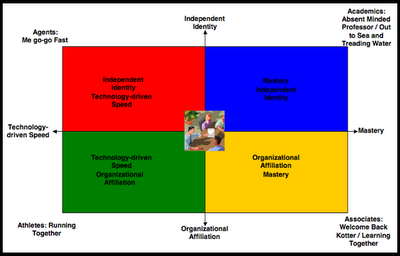Reports from the Knowledge Labs about our recent findings, research topics, and interviews with lifestyle leaders who are creating their own futures.
|
|
| |
How to stimulate your own powers of foresight. Consider the following thought provokers. Ask yourself, in these categories what are the brand new trends and forces? Which are the ones growing in importance? Which current forces are loosing their steam? Which have peaked or are reversing themselves? Which are the "wildcards" about to disrupt us in the future? POLITICAL AND TECHNICAL thought for food: Electronics, Materials, Energy, Fossil, Nuclear, Alternative, Other, Manufacturing (techniques), Agriculture, Machinery and Equipment, Distribution, Transportation (Urban, Mass, Personal, Surface, Sea, Subsurface, Space), Communication (Printed, Spoken, Interactive, Media), Computers (Information, Knowledge, Storage & Retrieval, Design, Network Resources), Post-Cold War, Third World, Conflict (Local, Regional, Global), Arms Limitation, Undeclared Wars, Terrorism, Nuclear Proliferation, Weapons of Mass Destruction, Governments (More/Less Power and Larger or Smaller Scale), Taxes, Isms: Nationalism, Regionalism, Protectionism, Populism, Cartels, Multinational Corporations, Balance of Trade, Third Party Payments, Regulations (OSHA, etc.) Environmental Impact, U.S. Prestige Abroad. SOCIAL AND ECONOMIC Food for thought:
Labor Movements, Unemployment / Employment Cycles, Recession, Employment Patterns, Work Hours / Schedules, Fringe Benefits, Management Approaches, Accounting Policies, Productivity, Energy Costs, Balance of Payments, Inflation, Taxes, Rates of Real Growth, Distribution of Wealth, Capital Availability and Costs, Reliability of Forecasts, Raw Materials, Availability and Costs, Global versus National Economy, Market versus Planned Economies, Generations: Y, X, Boomers, Elderly, Urban vs. Rural Lifestyles, Affluent vs. Poor, Neighborhoods and Communities, Planned or Organic Growth.
Got Knowledge?
|
|
| |
|
|
|
|
The Journal of 2020 Foresight
|
|
| |
|
Thursday, August 03, 2006

Birds-Of-A-Feather Cultures: Choosing Organizations by the Talent They Keep
Chapter Four: The Tribal Territories
By Steve Howard, CKO
The Knowledge Labs
Table of Contents
Chapter One: Basecamp
Chapter Two: The Ridge
Chapter Three: The Outpost
Chapter Four: The Tribal Territories
“Every day I’d come in with a new song. Usually wrote it on the way over there. I’d stop my car and write a little bit. Then when it stopped coming I’d move my car about 500 yards and stop again. There was a whole bunch more material there. So I wrote that down too. Anyway, it’s too bad. ‘Cause I liked Grandpa.”
Neil Young & Crazy Horse “Greendale”
DOUBLE NICKEL RANCH. The 19 trends identified by the human resource executives that addressed how future organizations would deal with talent sorted into a four- box matrix. Each box told a qualitatively different story about threats and opportunities confronting both executives and the talent they lead and develop.
Journal of 2020 Foresight: How did you come up with the four working titles?
Explorer: Between Eagle’s input and a best seller about the world of the free-lance workers – Free Agent Nation, the first one – the red box on the upper left at the intersection of an independent identity and technology-driven speed -- was a natural: “Agents: Me Go-Go Fast.”
J2020F: How about the green one, directly below it?
Explorer: We picked up on the pattern of star players who craved individual recognition, but who only achieved their goals at a fast pace through teamwork. So that translated into a relay race, or “Athletes: Running Together.”
J2020F: And it looks like they shared an organization affiliation with the box to their right in gold.
Explorer: Yes, but the difference, we discovered was in the affiliation needs provided by the team.
J2020F: As contrasted how?
Explorer: A close-knit identity developed by athletes performing together against the clock – like professional sports teams winning a championship for a season or two before trades dismantle them -- as contrasted to an organization that had a history of teamwork and developed a shared community identity.
J2020F: So they learned together through participation on a variety of teams with a variety of people?
Explorer: Yes. And they identify with the mission, core values and brand of the larger organization with some history.
J2020F: So the bond is strong enough that a “student comes back as a teacher” to give back to the organization?
Explorer: Very good. That’s the theme we felt when we named it – “Associates: Welcome Back Kotter / Learning Together.”
J2020F: So the relationship is longer term.
Explorer: This is also about learning informally together and preserving that organizational memory over time in knowledge sharing traditions. Today, just like it is rare for a professional athlete to play out his whole career with one team, we believe Gen X and Gen Y members look at long-term career relationships as a thing of the past, so organizational affiliation dries up as a key talent attraction.
J2020F: And, what about the last one, also sharing a mastery dimension, but with an independent identity.
Explorer: The blue one we named “Academics: Absent Minded Professor / Out to Sea and Treading Water.”
J2020F: That takes a little explaining.
Explorer: Here the identity is independent of an organization, but is tied to a profession. So, from a talent stand point we saw them as specialists who subscribe to a methodology – usually requiring advanced training.
J2020F: What about the mixed metaphor?
Explorer: To be honest we struggled as well. What we wanted to capture is that you can be so into your profession – following a sequence of logical steps that you lose sight of your employer’s mission and goals in the short-term.
J2020F: What about the treading water part?
Explorer: If you decide to hang out your shingle as a sole-practitioner, you will be treading water. You won’t enjoy those close professional discussions in a community of colleagues.
J2020F: What is the relationship between talent cluster and innovation and knowledge?
Got Knowledge?
Copyright ©2002 - 2006 Aarnaes Howard Associates. All rights reserved worldwide.
9:46 AM
|
|
| |
|
|
|